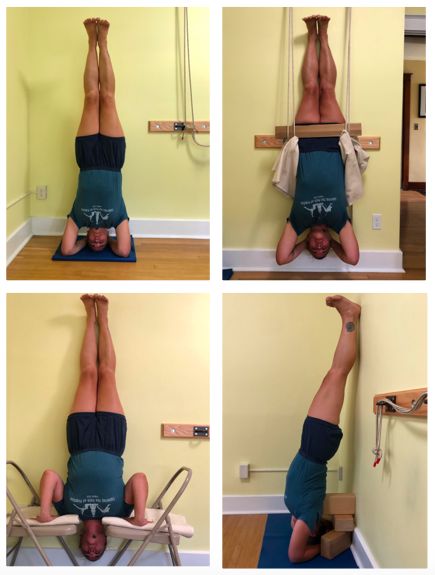Why Would I Want to Stand on My Head?

As I am teaching the “Back to Basics” class for The Yoga Place, of course we touch on building the strong foundations needed to practice future inversions. One of the beautiful things about yoga is the way it changes your perspective and the way you experience your body and mind in general. In the Iyengar method, we do put strong emphasis on the inversions and though we don’t often list all the reasons why, sometimes it helps to look back, read the texts left to us by the masters, and be reminded of how much we have to learn!
In the last weeks, this question of why someone would want to stand on their head, but also a couple of other experiences I have had, have driven me back to Light on Yoga by BKS Iyengar (copyright 1966) and The Yoga Sutras of Patanjali (copyright between 200-500 BCE). Many Westerners might find these texts “old” or “inapplicable” to our modern scientific age, and yes BKS Iyengar often said that a lot of the posture photos in Light on Yoga were “dead” because of his evolution of study of himself and others. However, what I read in the articles and journals of modern science today, neurology and physics in particular actually continue to prove the wisdom of the ancient sages of yoga right. So, it does us good to continue to replenish our knowledge of yoga through what the actual yogis discovered and shared.
The wisdom of the sages in the East was all completely discovered by practice, self study, and actual experience. It is not lab testing and external sources that told them so, but the internal truths of their own study of the layers of their own being. For me, it is awe inspiring and a little dumbfounding that we can continue to learn and trust in so much of that knowledge from the past while simultaneously applying such knowledge to our modern experience as well. This is what makes yoga a “Universal Subject” unbound by time, class, or place, and is what draws me deeper and closer to myself with every practice.
The following is part of the excerpt from Light on Yoga that lists the “Effects of Sirsasana”. The genius of BKS Iyengar’s life study left us with so many ways to practice this incredible pose despite any issue, ailment, or setback. It is advisable, of course, not to jump into the practice of headstand without supervision of a certified teacher, and even though our method stresses the practice of inversions, there is always variation and alternatives to practice when needed.
I can attest to many of these effects listed below, and though I know that fear and trepidation comes up in a beginner just starting out, building a good foundation in yoga will make it a safe and nurturing practice in any pose for the long term.
“The ancient books have called Sirsasana (headstand) the king of all asanas and the reasons are not hard to find. When we are born, normally the head comes out first and then the limbs. The skull encases the brain, which controls the nervous system and organs of sense. The brain is the seat of intelligence, knowledge, discrimination, wisdom and power. It is the seat of the soul. A country cannot prosper without a proper king or constitutional head to guide it; so also the human body cannot prosper without a healthy brain…
The head is the center of sattvic (balanced energy) qualities which control discrimination; the trunk of rajasic (active and alert energy) qualities which control passion, emotion and actions; and the region below the diaphragm of tamasic (inert energies) qualities which control sensual pleasures like the enjoyment of food and drink, and the thrills and pleasures of sex.
Regular practice of Sirsasana makes healthy pure blood flow through the brain cells. This rejuvenates them so that thinking power increases and thoughts become clearer. The asana is a tonic for people whose brains tire quickly. It ensures a proper blood supply to the pituitary and pineal glands in the brain. Our growth, health and vitality depend on the proper functioning of these two glands.
People suffering from loss of sleep, memory and vitality have recovered by the regular and correct practice of this asana and have become fountains of energy. The lungs gain the power to resist any climate and stand up to any work, which relieves one from colds, coughs, tonsillitis, halitosis, and palpitations. It keeps the body warm. Coupled with Sarvangasana (shoulder stand) movements, it is a boon to people suffering from constipation. Regular practice of Sirsasana will show marked improvement in the hemoglobin content of the blood.
It is not advisable to start Sirsasana and Sarvangasana when one suffers from high or low blood pressure.
Regular and precise practice of Sirsasana develops the body, disciplines the mind and widens the horizons of the spirit. One becomes balanced and self-reliant in pain and pleasure, loss and gain, shame and fame and defeat and victory.”
“Effects of Sirsasana” – Light on Yoga by BKS Iyengar
Stay tuned for the next blog on the effects of Sarvangasana (shoulder stand), the needed balance to the King of asana, and the Mother of all postures!